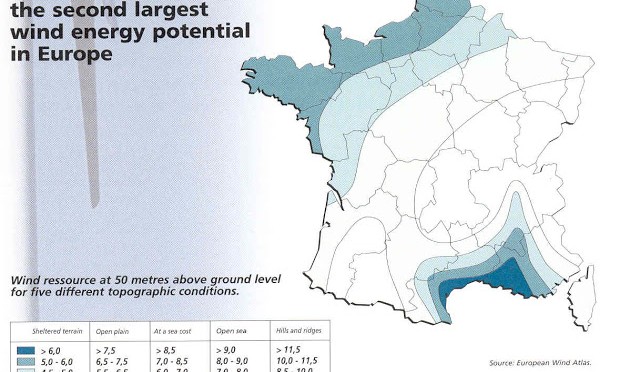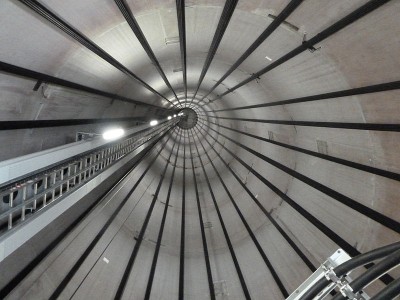France’s wind energy sector has set ambitious goals: the country plans to install 19,000 MW of energy in onshore wind farms and 6,000 MW in offshore farms by 2020. The allotted time periods are short and the obstacles are many, but where there’s a will, there’s a way. In fact, France has many advantages that will help its wind sector excel and meet its commitments.
Observ’ER, an observatory of renewable energies, has published a barometer of renewable electrical energy in France. The report reveals that since 2011, there has been a steady decline in the annual amount of onshore wind power added to the grid. Less than 350 MW were installed in the first trimester of 2013, representing a 38 percent decline from 2012 and yielding a total power of 7,971 MW.
At this rate, the country has a slim chance of reaching the goal of 19,000 MW installed by the end of 2020. But should the enthusiasm that dominated in the early 2000s, when wind power represented the future of renewable energy in France, be abandoned? Not by a long shot.
Environmental blog Ma Terre (My land) explains what is at stake with renewable energy in France:
Dans les périodes où nos besoins en électricité sont les plus importants (par exemple, les soirs d’hiver en période de grand froid quand il faut beaucoup chauffer les bâtiments), le nucléaire ne peut pas tous les satisfaire. Ce sont alors d’autres énergies qui prennent le relais […] L’avantage de diversifier les sources de production électrique est de ne pas dépendre d’une seule énergie, et donc de réguler au mieux la production.
During times when our electricity needs are greater (i.e, during cold nights in winter when it takes a lot of energy to heat up buildings), nuclear energy cannot satisfy them all. Other types of energy sources are called upon to also contribute to energy production […] The advantage of diversifying the sources of electricity production is not being dependent on a single energy source, and thus better regulatating the overall national production.
Eliminating the uncertainty around purchase prices
Besides the increase of installation costs and the decline in funding sources, an important cause of the wind sector’s slackening is the uncertainty surrounding the purchase prices of electricity produced by wind energy in France:
La législation française prévoit que les producteurs d’électricité d’origine éolienne bénéficient d’une obligation d’achat de l’électricité à un prix supérieur à celui du marché. Ce mode de financement engendre donc des surcoûts pour les distributeurs d’électricité, EDF en tête. Or, ces surcoûts font l’objet d’une compensation intégrale financée par des contributions dues par les consommateurs finals d’électricité.
French legislation has planned for wind energy producers to benefit from an obligatory purchase price that is higher than the market rate. This method of financing thus creates increased costs for electricity distributors, mainly the EDF [Electricity of France]. But these increased costs are the object of a full compensation financed by the final consumers of electricity.
Stakeholders in wind energy are trying to offer solutions to these known complications, as the onshore sector already possesses the equipment and knowledge necessary for its development.
However, legal delays must also be taken into account. The Council of State, a body of the French government that acts as a legal adviser of the executive branch, is due to come to a resolution on eventually doing away with a tariff order that could create a period of uncertainty detrimental to the wind sector’s recovery from the economic deficit it created during the 2000?s.
Reinforcing plans for offshore wind farms
Regarding offshore wind farms, the first industrial bearings have already been installed in a more than favorable location: a vast expanse of sea (11 square kilometers spanning four coastlines) and harbor areas that are conducive to accommodating the necessary infrastructure. In 2011, four sites were awarded to the consortium distributor EDF EN (a branch of EDF dedicated to renewable energy) : Fécamp (498 MW), Courseulles-sur-Mer (450 MW) and Saint-Nazaire (480 MW). The Saint-Brieuc site was awarded to Ailes Marines SAS.
The second round of offshore tender, launched in 2013, dealt with two zones: one off the coast of Tréport, and the second on the Plateau des Bœufs, off the islands of Yeu and Noirmoutier. The power at stake is 1,000 MW. Two consortiums submitted proposals for the zones: EDF-EN and WPD (Wind Power Development) in partnership with Alstom, and GDF (Gaz de France) Suez and EDP (Energias de Portugal), associated with Areva. The two wind farms are slated to become operational between 2021 and 2023.
The call for offers was welcomed in 2013 by Jacques Auxiette, president of the Pays de la Loire region:
Avec celui du banc de Guérande, la construction de ce deuxième parc éolien en mer permettra d’atteindre la taille critique nécessaire à l’émergence d’une filière qui devrait générer à terme plus d’un millier d’emplois et plusieurs milliards d’euros de retombées économiques.
Combined with the Banc de Guérande, the construction of this second offshore wind farm will permit the wind energy sector to reach the size necessary for it to emerge as an eventual source of a thousand jobs and several billion euros in economic yield.
But energy deadlines are looming here as well. Environmental summits set the goal of installing 6,000 MW of offshore energy by 2020. But between 2017 and 2019, France will have barely installed the 2,000 MW from the first round of offshore tender.
Therefore, the contenders for the projects at Tréport and the islands of Yeu and Noirmoutier will have to propose projects that meet the demands of the energy deadlines. This implies that they will have to minimize the margin of error between theory and practice in order to avoid the risk of unpleasant surprises when the engineers’ plans meet the reality of the terrain.
On the part of Alstom/EDF EN/WPD, there is no doubt that their project conforms with the demands of the environment. The consortium has already conducted studies (on ornithology, geotechnology, currents, and more) that are assets to their proposal. Their 6 MW Haliade turbines have been tested at the onshore site Carnet en Loire-Atlantique since 2012. About the specifics of the proposed turbines, the blog Mer et Marine ( Marine and Sea) signals that it could be the adequate solution if the conditions are right:
La question est alors de savoir si, dans les zones visées, il y a suffisamment de vent dans l’année pour produire le maximum d’énergie
The key question is whether, in the targeted areas, enough wind will blow during the year to produce the maximum energy
They are also currently installed at the Belwind site in Belgium to test their performance in an offshore setting. These are the results of the AOF (Alstom Offshore France), which, eager to stay at the forefront of the wind energy sector, joined the government’s 2011 Grand Wind project. These turbines have the advantage of using permanent magnet alternators, which are more reliable and thus incur lower maintenance costs.
The proposal by GDF-Suez/Areva/EDP includes an 8 MW turbine. At this time, the turbine is still at the beginning of its development process, and the consortium has not yet obtained authorization to test it. In the unlikely event that Areva manages to develop the turbine in time, will it be adapted to the terrain it is intended for? In the absence of technical and environmental impact studies by the consortium, this is a necessary question to consider.
Because they are early in the development process, the consortium has not rectified the technical problems revealed by a close examination of the turbine. Its full power cannot be exploited off the coast of the Vendée region, where the winds seem too weak to turn the turbines at full speed. The installation of jacket foundations may present problems as well. This type of foundation requires boring into the sea floor, which is particularly hard in the planned development zone. EDF EN, on the other hand, has conducted a comprehensive soil study via drilling test holes, and has chosen to prioritize gravity foundations, which do not require boreholes.
On paper, the GDF project would occupy less space, as it includes fewer turbines (62, compared to the 83 machines proposed by EDF EN). But it appears that the GDF wind farm would actually be larger than that of the EDF and would thus have greater impact on the maritime public domain. The Regional Committee of Marine Fisheries and Marine Farming (COREPEM) has decided in favor of the EDF EN project.
France now faces a race against the clock to meet the deadlines that it has imposed for the wind sector. While the timeline is pressing, the task is not impossible. It would require a rapid resolution on a new tariff order to restore visibility and confidence to the sector. Regarding the still-young offshore sector, the industrial projects seriously prepared in advance must take priority in order to have the best chance of meeting the sector’s goals.



